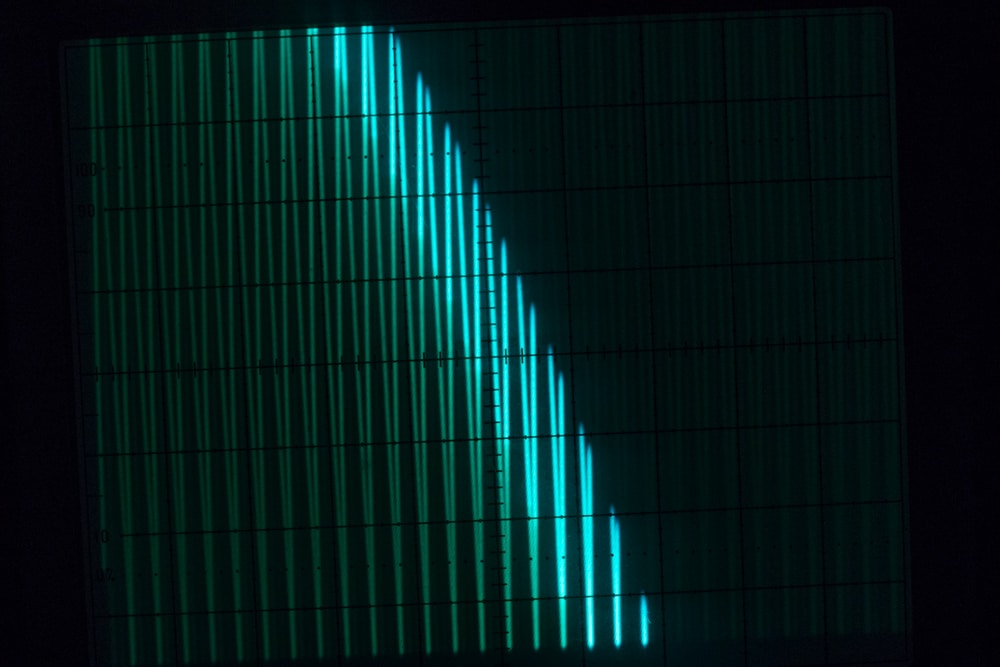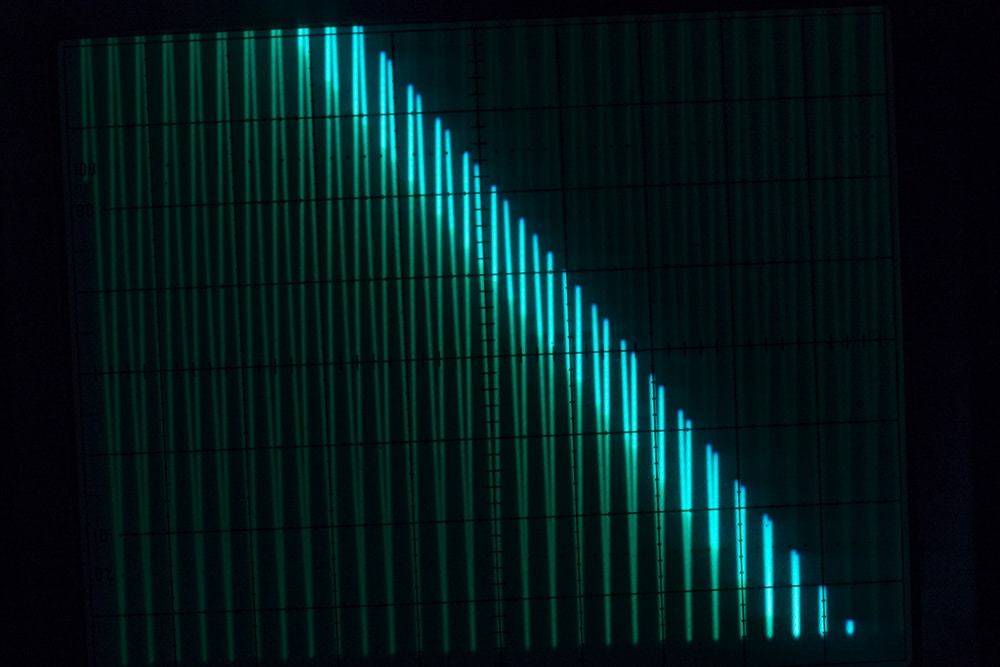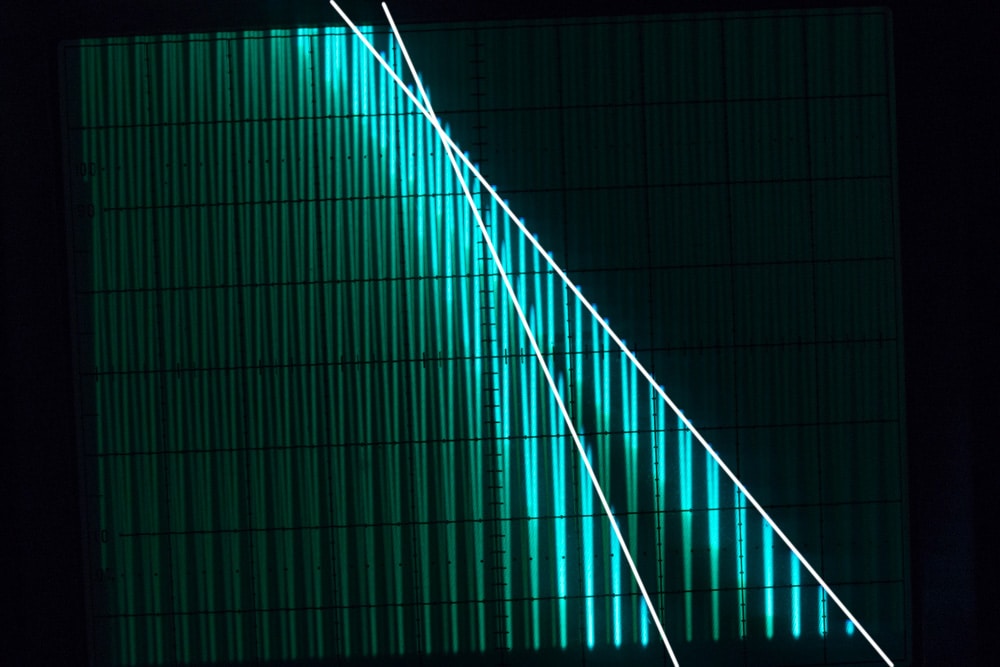This is the fifth in a series of posts on the Sony a9. The series starts here.
The biggest news about the a9 is the electronic shutter. Sony says it’s fast, but they don’t say how fast? Is it only half-fast? (Sorry, couldn’t resist.) The electronic shutters on previous Sony a7x cameras have scan times which vary from about 1/14 second to 1/30 second for a full frame image.
I set up an oscilloscope, set the time base of 1 millisecond per division, attached a function generator to the vertical input, and set the trigger mode to free run. Then I took a picture with the mechanical shutter in EFCS mode at 1/1000 second:
The scope trace runs from left to right, so earlier time in on the left. So the shutter runs from the top of the image (bottom of the camera) to the bottom of the image (top of the camera).
Then I did the same thing with the electronic shutter:
It is slower, and also more linear. You can see the mechanical shutter accelerating at the top of the top image.
Superimposing both images in the same frame and making some construction lines:
It’s hard to see the vertical lines which are the time base divisions, but here’s what I see. The mechanical shutter takes about 3 and a half divisions, or 3.5 milliseconds, to get from the top to the bottom. That’s a little slower than 1/300 second. The electronic shutter does the job in a little over six divisions, or 6-plus milliseconds. That’s about 1/150 second.
That speed puts the a9 silent shutter a little slower than the slowest of the a7x mechanical shutters. That’s quite an accomplishment.
There may be a clue in the maximum shutter speed of the a9 in ES mode, which is 1/32000 second.
The a9 sensor height is 4000 pixels. Let’s say the transit time is 1/150 seconds. That means the reset signal and the read operation both move up the sensor at 600,000 rows/second. To have a 1/32000 second exposure, the read operation would have to be 600,000 / 32000 = 18.75 rows behind the reset operation. The non-integer result of this calculation probably means that my measurement is wrong. If it were 18 rows, then the scan rate would be 576,000 rows/second, and the transit time would be 1/144 seconds.
If it’s 20 rows, then the scan rate would be 640,000 rows/second and the transit time would be 1/160 second.
I’m liking 1/160.



Boh says
Just curious as to why electronic shuttle would be slower than mechanical shuttle?
CarVac says
At first thought, that would be true, but the only way to end the exposure of a given pixel on most CMOS architecture sensors is to read out the value.
To end the entire exposure, you have to read every pixel on the sensor. For most still cameras thus far, this takes longer than it takes for a shutter curtain to cross the sensor.
adith says
Processing speed, the camera has to go to each pixel, and read the count. For a camera will over 24 million pixels, this takes a lot of time. On a shutter camera, the shutter limits the exposure time, then the camera can take its time to read the pixels. This way it doesnt matter how long the camera takes to read them, because they arent getting any more light anyway.
On this electrical shutter, its basically reading them as they fire (or I would assume, I doubt Sony has released the mechanism) so unlike a mechanical shutter it is severely limited by the speed of the camera. the longer it takes to read, the slower it can move from one pixel to another. We could, of course, use parallel processing, like a computer’s GPU but this would be heavy, expensive, and require a cooling system.
Joel says
Really wish Sony gave us the option to use ES with flash at a 1/125 or 1/150 sync speed. Sigh. Minor niggle.
adith says
Just an FYI but you have a typo in the article
>The scope trace runs from left to right, so earlier time in on the left. So the shutter runs from the top of the iamge (bottom of the camera) to the bottom of the image (top of the camera).
>iamge
Bill Bryden says
Was soo hoping you’d test this. Thanks!
Lynn Allan says
Thanks for providing these test results.
I’m being slow here, but what does this mean as far as impact on a photo?
Is this related to “rolling shutter”? Does it mean fast moving objects like a fast windmill blade or swinging baseball bat will look distorted?
https://www.dpreview.com/articles/5816661591/electronic-shutter-rolling-shutter-and-flash-what-you-need-to-know
For purposes of comparisons, what are “good / better / best” values, such as from a Nikon D5, Canon 1Dx ii, or others?
JimK says
It means little chance of banding with 120 Hz and 100 Hz light sources like CFLs and home LED lighting. If means that there won’t be much more distortion of fan blades etc. than with a mechanical shutter. It’s good news.
Ilias says
>If it’s 20 rows, then the scan rate would be 640,000 rows/second and the transit time would be 1/160 second.
>I’m liking 1/160
Jim,
why not 19 rows ?? 4000/(19*32000) = 1/152
But .. searching for integer row numbers .. we have to use the full sensor height which is 4024 .. also 1/32000 maybe not be exactly so ..
Taking accound of the 3 and 6 row repeatability of FPN I would vote for a multiple of 3 or 6 .. so either 18 or 21 rows slit 😉 (thinking of 2*3 ADCs per column ..)
But .. I’m liking to count on the exactness of your measures 😉 so I vote for 19 rows 1/152 ..
Daniel says
I have a question regarding the a9 sensor readout in video mode, does anyone know how fast it is in 4k 25p? I have a A6300 and it’s around 35ms readout in 4k, just to slow for any fast movement.
Nicholas Savenlid says
I would like to see the same test for the Nikon D810 m-shutter
Possibly the D810 m-shutter is not faster.
maybe not possible to evaluate using exact same setup but i am pretty sure it can be measured.
JimK says
What do you mean by “m-shutter”?
Tucker Downs says
I think Nicholas means mechanical-shutter.
JimK says
In that case, here’s the answer:
https://blog.kasson.com/the-last-word/efcs-on-the-nikon-d810/
Tucker Downs says
Jim, This is a great article. I’m doing a bit of research on shutter traversal times for professional cinematic cameras and I’d like to reproduce your tests, but we do not have an analog oscilloscope. Any ideas on other ways we might produce this?
JimK says
Get a light source that is modulated at a known rate and count the bands?
Tucker Downs says
Thanks for the advice Jim, It was very helpful, despite seeming so obvious now. I’m feeling obligated to share the results. Since you seem to be so willing to help others and publish your findings, I’ll follow your example.
I have a light source that I can very precisely control the modulation of. I set the source to it’s fastest speed, 1/1920 off, followed by 1/1920 on. With a very high shutter speed set I was able to measure the shutter traversal time of RED Epic Mysterium-X to be 10.4ms +/- 0.26ms.
WAY slower than I expected it to be seeing as the sensor has a much lower resolution than the a9 and costs considerably more. I guess the money went elsewhere.
JimK says
Thanks for the results!
Tucker Downs says
Ah. That would work well. I think we should be able to do that. I’ll be sure to comment back if we get can get some results.
Bryan says
Jim,
This article was unbelievably helpful – I want to do BTS photography for film productions without resorting to a DSLR and blimp, so I’m planning to purchase a camera with a great silent shutter mode.
The a9 seems perfect, but is too expensive for me at this time. I hope you continue to test the ES speeds on other mirrorless camera models in the future. Thank you!!
Michael Jardine says
Hi Jim,
So if the transit time is 1/160 sec, and I’m shooting and panning at 1/1000 sec, I may reduce or elliminate the blur but isn’t it still possible to still have distortion?
JimK says
Sure, if your subject is moving fast enough. That’s true of any focal plane shutter that’s not a global shutter, not just electronic ones.